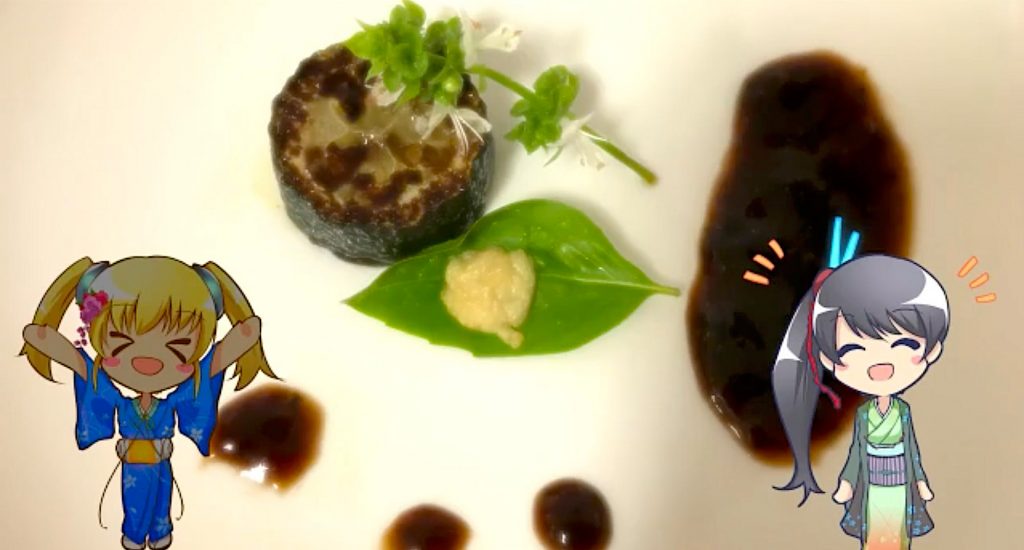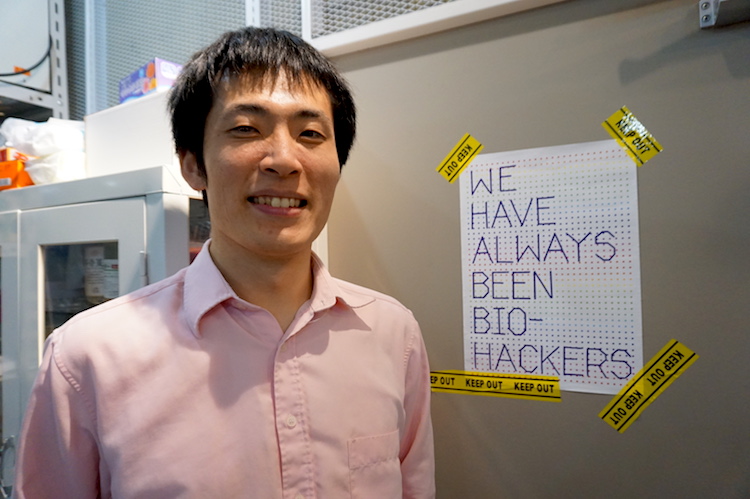
Foie gras (center) cultivated by Shojinmeat (screen capture). © Shojinmeat Project
Before the industrial vats, Shojinmeat Project’s first objective is to culture meat cells in home incubators. This Japanese citizen science movement has nothing to do with artificial burgers or vegan activism.
From our correspondent in Tokyo (words and photos)
Scientists call it cultured meat. Activists call it clean meat. Sceptics call it in vitro meat. All refer to meat grown from animal muscle cells cultured in a laboratory. Real meat without killing animals…
The future of meat?
Shojinmeat Project was directly inspired by science-fiction, far from the commercial approach of Memphis Meats, far from the activism of American vegans (Hampton Creek and Beyond Meat) and the ecological pragmatism of scientists in the Netherlands (Cultured Meat at Maastricht University) or Israel (SuperMeat and the Modern Agriculture Foundation). The instigator of Shojinmeat Project, Yuki Hanyu, has since childhood been fascinated by numerous manga and anime that pictured people self-sufficiently growing meat without animals for their own gourmet meals.

Contrary to what the superlative media headlines would have us believe, the concept of cultured meat is not new, and not even from this century. As early as 1931, Winston Churchill predicted in his article “Fifty Years Hence” that “We shall escape the absurdity of growing a whole chicken in order to eat the breast or wing, by growing these parts separately under a suitable medium.”
Since then, researchers have been experimenting with muscle tissue cell cultures and filed patents in the United States. NASA has been growing meat to eat in outer space. And bioartists continue to draw mainstream attention. The last big media spotlight on real cultured meat was in 2013, with the “250,000€ burger” prototype grown in a lab by Maastricht University professor Mark Post, now CEO of his own cultured meat company.
Eating biohacked mouse
With a background in biochemistry, Yuki Hanyu launched Shojinmeat Project in 2015 with Dr Ikko, a specialist in regenerative medicine and organ tissue culture, who is also the cofounder of Lab-Cafe, a café that incubates future-oriented projects, where they first met.

The two scientists started doing experiments after hours in the lab and at home, culturing chicken cells from a fertilized egg purchased at the supermarket, then replacing a few conventional ingredients (such as costly fetal bovine serum) of the culture medium with more common ingredients, such as sports drink. Then they placed the cell culture in a consumer incubator the size of a microwave oven. Depending on the quantity, the cells can multiply exponentially after two or three weeks, says Yuki. In this way, they reduced the cost of meat cell culture to a few hundred dollars and made the entire process accessible to citizen science.
“Biotechnology is expensive. Our strategy, even before we got started, was to make all the research cheap. That’s where biohacking and DIYbio come in.”
Yuki Hanyu, founder of Shojinmeat Project
They documented every step on the project’s blog and presented their open source method in a video (in Japanese) showing them, within two weeks, growing, cooking and eating meat… cultured from mouse cells. The biochemist specifies that they bought the mouse cells from the JCRB cell bank. And what exactly was the taste of salted rodent fried in olive oil? “Just like KFC,” Yuki replies. He assures us that the method of cell culture is the same for any animal. More recently, the team made a new video documenting their cell culture of foie gras.
In Japan, Shojinmeat Project’s DIYbio movement of cellular agriculture has created a network of a few dozen passionate volunteers, whose individual motivations range from environmental sustainability to pure curiosity.
In particular, the project inspired illustrated characters who appear on the website and in a manga fanzine. The first volume details the recipe for DIY meat, while the second volume, released this summer, presents Shojinmeat in the global context of clean meat.
In August, a high school student who had used Shojinmeat’s method and equipment to culture meat in her home was the subject of a TV news report by Japan’s national public broadcaster NHK. Another group of high school students developed an educational presentation to teach the method to middle school students.
Coworking incubators
In the MTRL coworking space above Fabcafé Shibuya in Tokyo, which also contains the resident Bioclub’s members-only biolab, Yuki shows me the incubator used for this DIY cell culture, perched on a stand between a digital embroidery machine and a sewing machine.
Inside the incubator, an airtight plastic container tests for contamination resistance at a constant temperature of 37°C and 100% humidity. In the back, a bag maintains the concentration of carbon dioxide at 5%.
Shojinmeat Project has four such incubators: one at MTRL, another one at the laboratory, one that they lent to high school students who are growing shellfish, and one that is the personal incubator of a Shojinmeat member who cultures cells at home like others keep house pets. Yuki also says that the bioartist Michi Okada comes to MTRL often with the intention of culturing her own body cells.
Cellular agriculture for all
The ultimate objective of Shojinmeat Project is not only to empower anyone to grow their own gourmet food at home, but to generalize cellular agriculture on a large scale. In this way, the entire planet could be fed sustainably and humanely with “pure meat”, following the buddhist path of shojin, or purity and devotion, without violence or cruelty, whether on Earth or on Mars.
Integriculture, a start-up to scale up
While Shojinmeat Project’s volunteer network operates organically on its own, Yuki is developing Integriculture, the first start-up to come out of the Japanese cultured meat movement. The full-time CEO is busy attending conferences on cellular agriculture, presenting his low-cost open source technology, promoting his young entreprise and seeking out investors, including Silicon Valley venture capitalists. Shojinmeat Project’s notoriety has grown overseas since it won the Singularity University Japan Global Impact Challenge in February 2017.
But the biggest challenge, insists Yuki, is scaling up their cellular agriculture technology, well beyond the capacity of a start-up. To do so, he is actively seeking partnerships to collaborate with universities and companies, particularly in the industries of vitamin supplements, food, cosmetics…
“In the future, cellular agriculture will probably look like a yogurt factory or a beer brewery,” says Yuki. “Cell culture hasn’t been designed for this scale. This is exactly what we’re trying to do. Once we come up with cheap culture medium, then we will probably collaborate with yogurt or beer brewery people. Or in the case of Japan, better to talk with people in the fermentation industry, like sake. They have all the knowledge on how to run a food factory on this scale, in this manner. That’s when real scaling will happen.”
If Yuki predicts the possibility of cultured vitamin supplements as early as 2019, and cultured meat in supermarkets by around 2030, it goes without saying that legal regulations and social practices will also need to evolve.
As with any industrial and disruptive innovation, it will take time for it to be legally recognized, officially integrated and socially accepted. When it comes to the health and food safety issues of lab-grown meat, it’s no coincidence that the budding industry has marketed the term “clean meat”. “Because ‘real meat’ is actually quite dirty,” says Yuki. Cultured meat is much safer than “natural” meat that often comes augmented with growth hormones, he explains. And in slaughterhouses, fecal contamination is almost inevitable.
Pure meat
Shojinmeat Project’s strategy is to start with citizen science, giving priority to transparency and education around this open source technology. According to Yuki, it’s commercial monopoly and industrial secrets surrounding genetically modified organisms that led people to be wary of GMOs on the market. But if even schoolchildren can grow meat at home, then what is there to be afraid of?
Not to mention the ethical issues of raising and slaughtering animals. Does Yuki still eat red meat? “Anything goes, as long as it’s tasty,” he replies simply. “Preventing animal cruelty and animal rights are not really part of the social agenda in almost all of East Asia. On the other hand, we have a strong sense of food security. Japan’s self-sufficiency food rate is somewhere around 38%. We learn this from elementary school, so people are fully aware when it comes to food security. That is the driving force when it comes to clean meat and cellular agriculture in Japan.”
And when we consider that globally, according to the UN, bovine cattle produces up to 15% of greenhouse gases, while 62 billion chicken are slaughtered each year to feed us, it becomes evident that we need to change our current methods of producing and consuming meat. In terms of environmental sustainability and respect for animals, nothing beats veganism. But the reality is that meat is (still) part of our culinary culture.
More flexible than fake meat
“Even in the United States, clean meat is not in supermarkets—it’s just plant-based meat, trying to imitate meat,” says Yuki. “It has its place in the market. If you’re interested only in the nutritional aspects, then switching entirely to products like Impossible Burger is a possibility, yes. But the problem is that Impossible Burger is just a burger. It can’t be modified in any way. Culinary versatility is the biggest problem with plant-based meat. You can’t really cook it into something else. If you try to make curry with Impossible Burger, it just falls apart. Same thing with [Japanese dishes] sukiyaki or shabu shabu, it just falls apart. Yakitori just catches on fire. You can only eat it the way it’s marketed as. In countries where culinary tradition is not very strong like in the U.S. or the UK, it’s ok. But for France, Japan, China, it’s probably not the best option.”
Fish fat beef…
Another advantage of cellular agriculture, which should eventually progress from ground beef patty to finely sliced bacon to succulently marbled steak, is the possibility of culturing new meats—what Yuki playfully calls “designer meat”.
Even without gene editing, he talks about co-culturing beef and pork cells, for example, in order to create new cells that don’t exist in nature. “We don’t even know what it would taste like,” he chuckles. “We’re also working on something called ‘green meat’, which is basically algae-loaded meat. It’s a kind of superfood. Because we’re building meat from scratch, we can actually come up with whatever kind of meat, once the technology matures—fish fat beef, DHA omega 3+ meat, fig meat or kobe beet…”
Yuki says that researchers at the Tokyo Women’s Medical University (TWMU) are currently working on this technology, but they have not yet tasted the meat of their labor. Meanwhile, we can imagine an increasingly near future in which anyone can grow their own custom food at home, right beside their 3D printers…
Shojinmeat will co-host the Future Gastronomy Workshop at MTRL Shibuya on November 24
Shojinmeat Project website